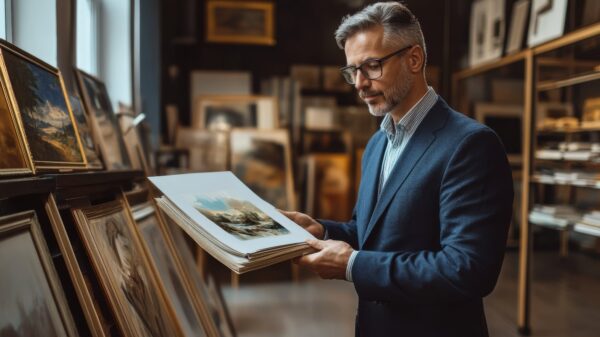Building an art collection is a deeply rewarding journey that intertwines personal taste with cultural appreciation and even financial investment. For aspiring collectors, stepping into the art world may feel intimidating. With endless styles, mediums, and artists to choose from, it’s easy to feel overwhelmed. Craig Nassi understands that with a thoughtful approach and informed strategies, starting your own collection can be an enriching and achievable endeavor. Here are some essential tips to guide you on this artistic adventure.
1. Define Your Purpose
Before purchasing your first piece, consider your motivation for collecting. Are you looking to beautify your living space, invest for financial growth, or support emerging artists? Your purpose will shape the direction of your collection. For instance, if you’re buying as an investment, you’ll want to focus on pieces with strong provenance and potential for appreciation. On the other hand, if your goal is personal enjoyment, prioritize works that resonate with your emotions and aesthetics.
2. Educate Yourself
Knowledge is power in the art world. Familiarize yourself with different art movements, mediums, and styles. Research renowned and emerging artists, attend gallery exhibitions, and read art books or magazines to understand current trends. Art fairs, museum tours, and online art forums are also excellent resources to expand your knowledge. The more you understand the art landscape, the more confident and informed your decisions will be.
3. Establish a Budget
Art collecting doesn’t have to break the bank. Set a budget that aligns with your financial situation and stick to it. Affordable options such as prints, photographs, or works by emerging artists can be a great starting point. Keep in mind that some artists offer limited editions or reproductions, which can provide an accessible entry into the market. Remember, art is not just for the wealthy—it’s for anyone with a passion for creativity.
4. Start Small, Think Big
You don’t need to purchase a Picasso or Monet right out of the gate. Begin with smaller, more affordable works that reflect your personal taste. Over time, as your knowledge and resources grow, you can expand your collection to include larger or more prestigious pieces. The key is to focus on quality over quantity, ensuring each addition has a meaningful place in your collection.
5. Build Relationships in the Art Community
Developing connections with galleries, artists, and fellow collectors is invaluable. Galleries often host events and exhibitions, offering opportunities to meet artists and discuss their work. Building these relationships can lead to insider knowledge about upcoming pieces, discounted prices, or even custom commissions. Networking with other collectors also provides valuable insights and shared experiences.
6. Trust Your Instincts
While advice from experts and peers is helpful, your collection should ultimately reflect your unique taste and perspective. If a piece speaks to you on an emotional or intellectual level, don’t hesitate to pursue it. Art is deeply personal, and the most cherished collections are those that authentically represent their owner’s vision and identity.
7. Learn the Basics of Valuation
Understanding how art is valued can help you make informed purchases. Factors such as an artist’s reputation, the rarity of the piece, its condition, and its provenance (the documented history of ownership) play a role in determining price. For investment purposes, look for works with certificates of authenticity and clear provenance to ensure their value holds over time.
8. Consider Emerging Artists
Supporting emerging artists is a win-win for collectors. Not only are their works often more affordable, but you also have the chance to support talent early in their careers. Emerging artists often bring fresh perspectives and innovative techniques, adding a dynamic element to your collection. Plus, if the artist gains recognition later, their works may significantly appreciate in value.
9. Diversify Your Collection
An art collection doesn’t need to adhere to a single theme or style. Experiment with different mediums such as paintings, sculptures, prints, photographs, or mixed media. Diversity can add depth and intrigue to your collection, reflecting your evolving interests and expanding appreciation for art.
10. Take Your Time
Building a collection is a marathon, not a sprint. Resist the urge to buy impulsively, especially if you’re unsure about a piece. Take your time to research, explore, and refine your taste. Your collection will grow organically, resulting in a more thoughtful and cohesive representation of your artistic journey.
11. Care for Your Art
Once you’ve acquired pieces, proper care is essential to maintain their condition and value. Invest in quality framing, avoid placing works in direct sunlight or humid environments, and clean them with appropriate materials. If your collection grows significantly, consider insuring it to protect against potential loss or damage.
12. Embrace Technology
In today’s digital age, online platforms have revolutionized the art world. Websites like Artsy, Saatchi Art, and Artnet provide access to galleries, artists, and auction houses worldwide. Social media platforms like Instagram allow you to follow artists and discover new trends. Virtual exhibitions and digital marketplaces make art collecting more accessible than ever.
Starting an art collection is an exciting and fulfilling journey that combines personal expression, cultural engagement, and potential financial rewards. By taking the time to educate yourself, define your goals, and cultivate relationships within the art world, you can build a collection that reflects your unique taste and passion. Whether your aim is to adorn your walls or invest in valuable works, the key is to follow your instincts and enjoy the process. After all, art is not just something to own—it’s something to experience and cherish.
